Thousands of years ago, the balance of dharma and adharma was at risk. The cries of the oppressed echoed through the heavens. In response, the divine forces created Goddess Durga. Born from the energy of the Trimurti—Brahma, Vishnu, and Shiva—Durga became the ultimate embodiment of Shakti. She was created to restore cosmic order and defeat the rising evil.
Adorned with celestial weapons, her radiant form shone brighter than a thousand suns. She rode a fierce lion, roaming the universe as the supreme protector. As the mother of all creation, she fearlessly annihilates the darkness threatening dharma. She is the essence of power, wisdom, and compassion, revered in countless tales of valor.
From the grand celebrations of Durga Puja in Bengal to the fervent Navratri festivities across India, Maa Durga remains the ultimate symbol of victory over evil. She empowers devotees to overcome their inner and outer demons. Her divine saga intertwines with legends of Mahadev, Vishnu, and other celestial beings, making her presence inseparable from the great cosmic play of the universe.
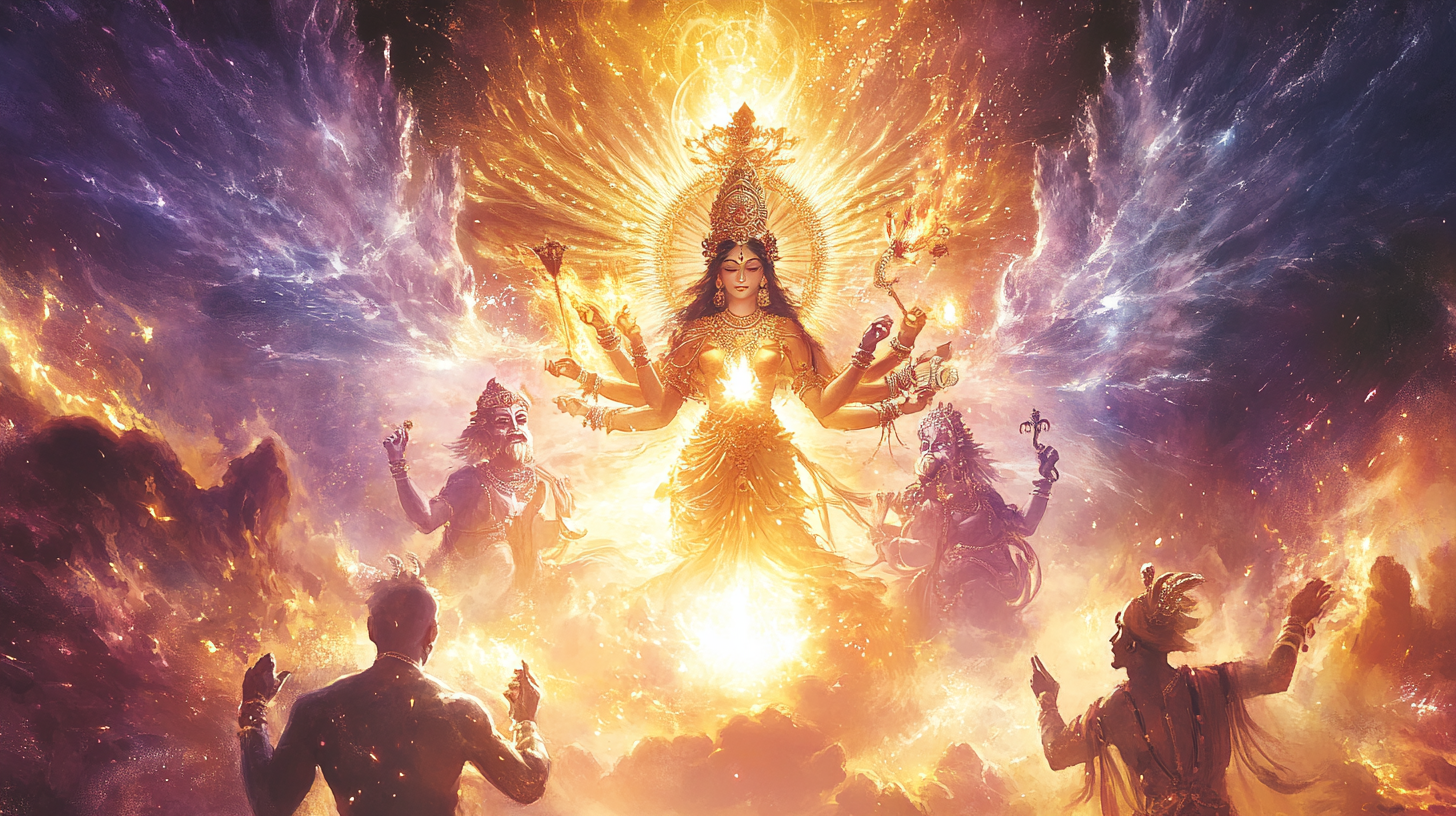
The Origins of Goddess Durga
Once, the three worlds trembled under the tyranny of Mahishasura, the formidable buffalo demon. Empowered by a boon from Lord Brahma, Mahishasura had become invincible against all men and gods. He wreaked havoc across the cosmos, forcing the devas into exile. The heavens shook as his army conquered Indraloka.
The gods, powerless before his might, sought refuge in the supreme trinity—Brahma, Vishnu, and Shiva. They pleaded for a divine intervention. Seeing the world engulfed in darkness, the great deities realized a power beyond the masculine was needed to destroy Mahishasura.
Then, a blinding light erupted from the bodies of all the gods, merging into a single, unparalleled force. From this divine energy emerged Maa Durga, radiant as a thousand suns. Her form embodied the strength, wisdom, and rage of the universe itself.
Her celestial form was awe-inspiring and majestic. Her ten arms carried the most potent weapons—Vishnu’s Sudarshan Chakra, Shiva’s Trishul, Indra’s Vajra, Agni’s spear, Varuna’s conch, and Yama’s sword, among others. Draped in a crimson saree, adorned with golden ornaments, and mounted on her lion, she roared with the fury of a thousand storms, shaking the heavens and the underworld alike.
As the gods bowed in reverence, Durga’s eyes burned with divine purpose. She was not just a goddess but the very manifestation of Shakti, the eternal cosmic energy, the protector of dharma, and the mother of all creation. With her arrival, the fate of Mahishasura was sealed, and the great battle for cosmic balance had begun.
Maa Durga’s Wars with Demons, Gods, and Humans
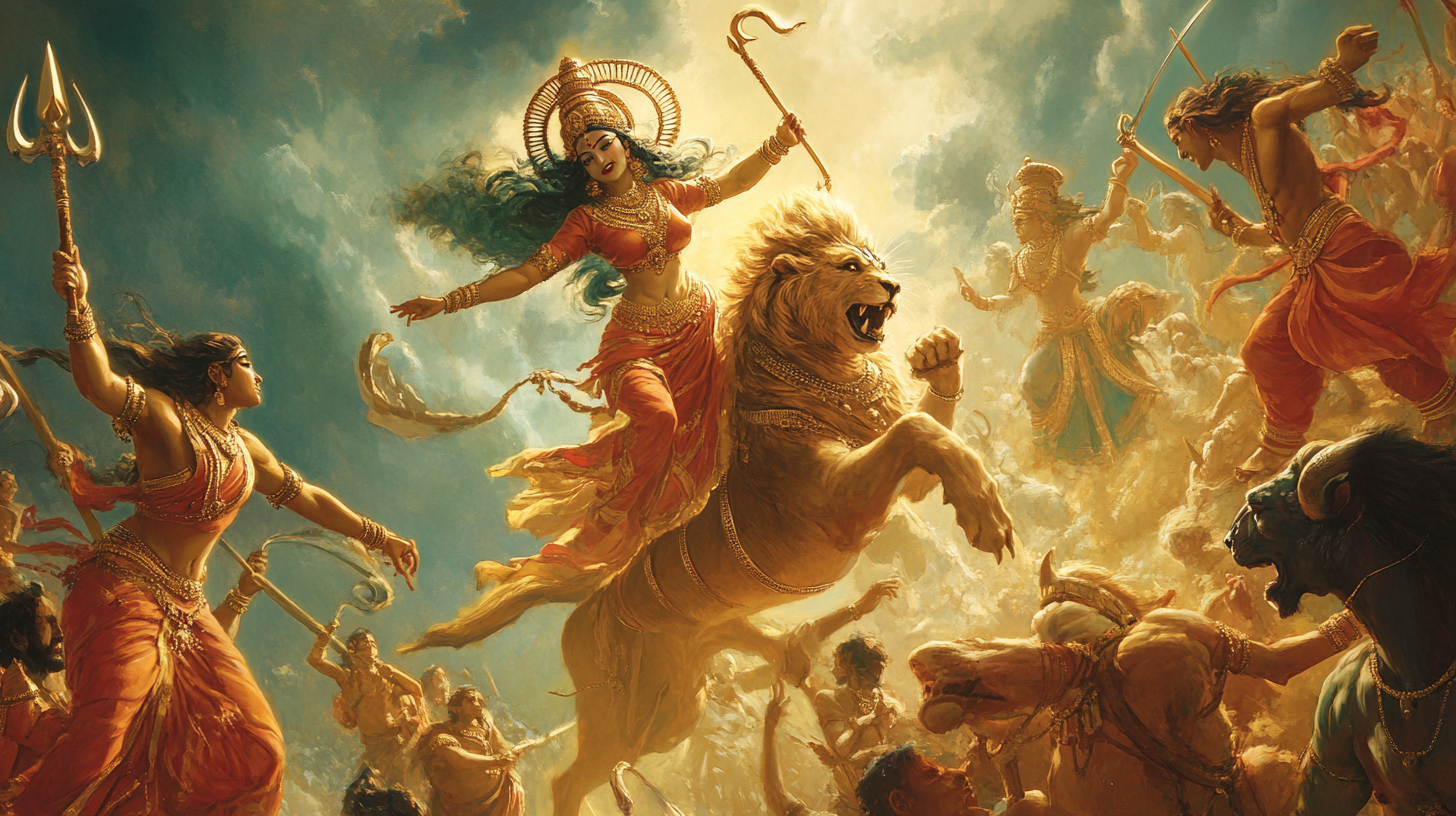
The Epic Battle with Mahishasura
In the golden age of Satya Yuga, the demon Mahishasura became a menace to all three worlds. With a boon from Brahma that made him invincible against all men and gods, he led his army of asuras to conquer Indraloka. The devas were forced into hiding. Desperate, the gods combined their energies to create Maa Durga, the warrior goddess who could not be defeated by any man or god.
The epic struggle between Mahishasura and Maa Durga lasted for nine days and nights. The demon transformed into various forms, from a lion to an elephant to a buffalo. Yet, Durga remained steadfast. When he took on his most formidable buffalo form, Maa Durga pierced his chest with her trident, ending his terror. This victory is celebrated as Vijayadashami, marking the triumph of good over evil.
👉 Read more about Lord Vishnu’s ultimate weapon, Sudarshan Chakra, used in battles: Sudarshan Chakra: Universe’s Most Destructive Weapon
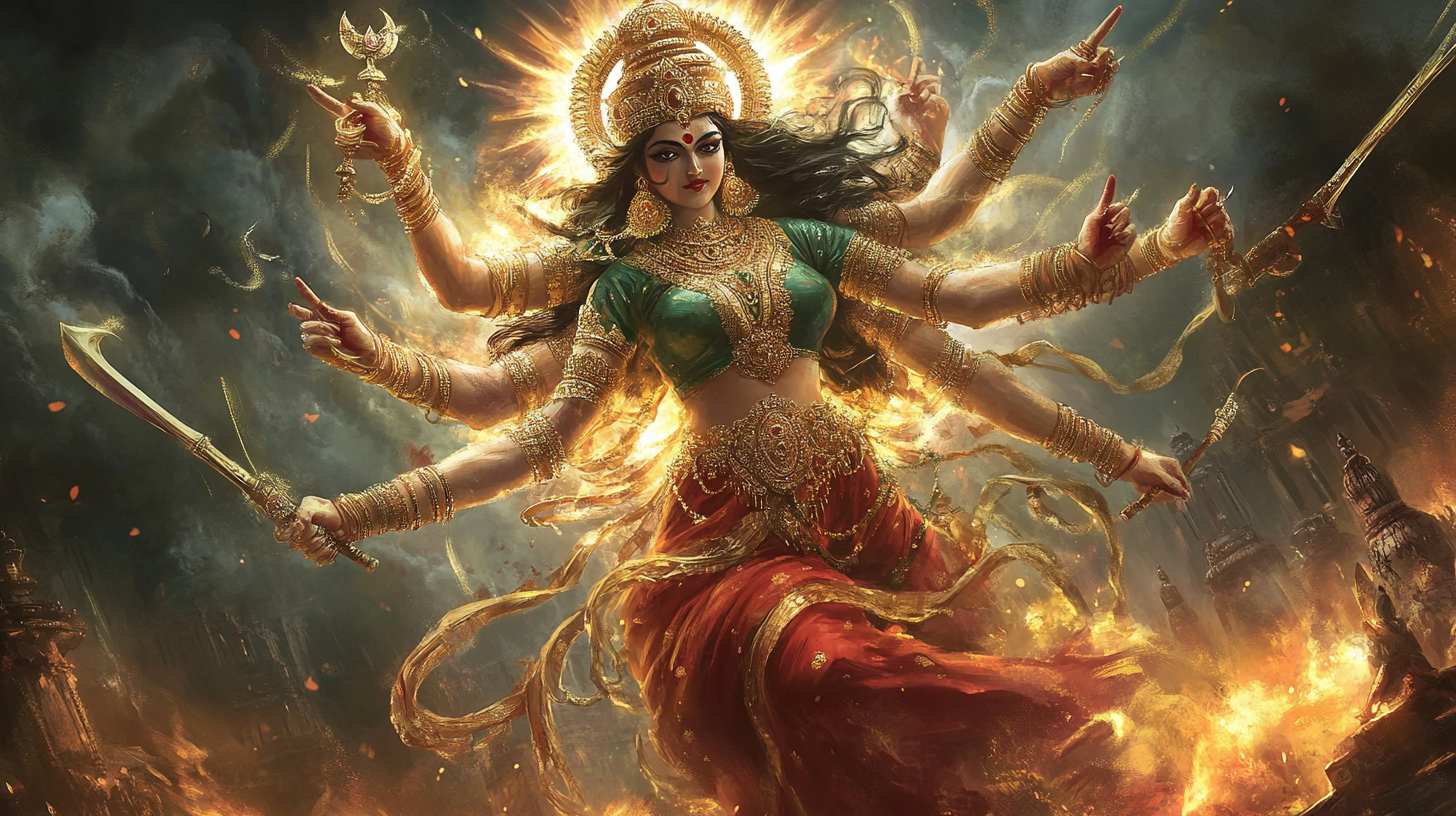
The Slaying of Shumbha and Nishumbha
In Treta Yuga, the demon brothers Shumbha and Nishumbha sought to dominate all three worlds. They performed intense penance and gained a boon that no male deity could kill them. Confident in their invincibility, they waged war against the gods, forcing them to flee from Swargaloka.
The gods, remembering Durga's victory over Mahishasura, prayed to her once more. In response, Durga manifested from Parvati’s divine energy as Kaushiki, a celestial maiden of enchanting beauty. Enamored by her radiance, Shumbha and Nishumbha sent their messengers to demand that she become their wife.
When she refused, an intense battle ensued. Durga called forth her fierce forms—Chandika and Kali—to slay their generals. As the battlefield turned crimson with asura blood, Nishumbha was the first to fall. Enraged, Shumbha challenged Durga, accusing her of using external powers instead of fighting alone. Smiling, she reabsorbed her various forms into herself and declared, “I alone exist in this universe. Now face me!” In a final strike, she pierced Shumbha’s heart with her spear, restoring cosmic order.
👉 Interested in other epic battles? Read about Shiva’s legendary wars: Stories of Shiva’s War
Dhumralochan’s Defeat
In the battle against Shumbha and Nishumbha, their general Dhumralochan was the first to challenge Durga. As he charged toward her with his massive army, Maa Durga simply let out a roar so powerful that it turned him to ashes, displaying her immense strength without even lifting a weapon.
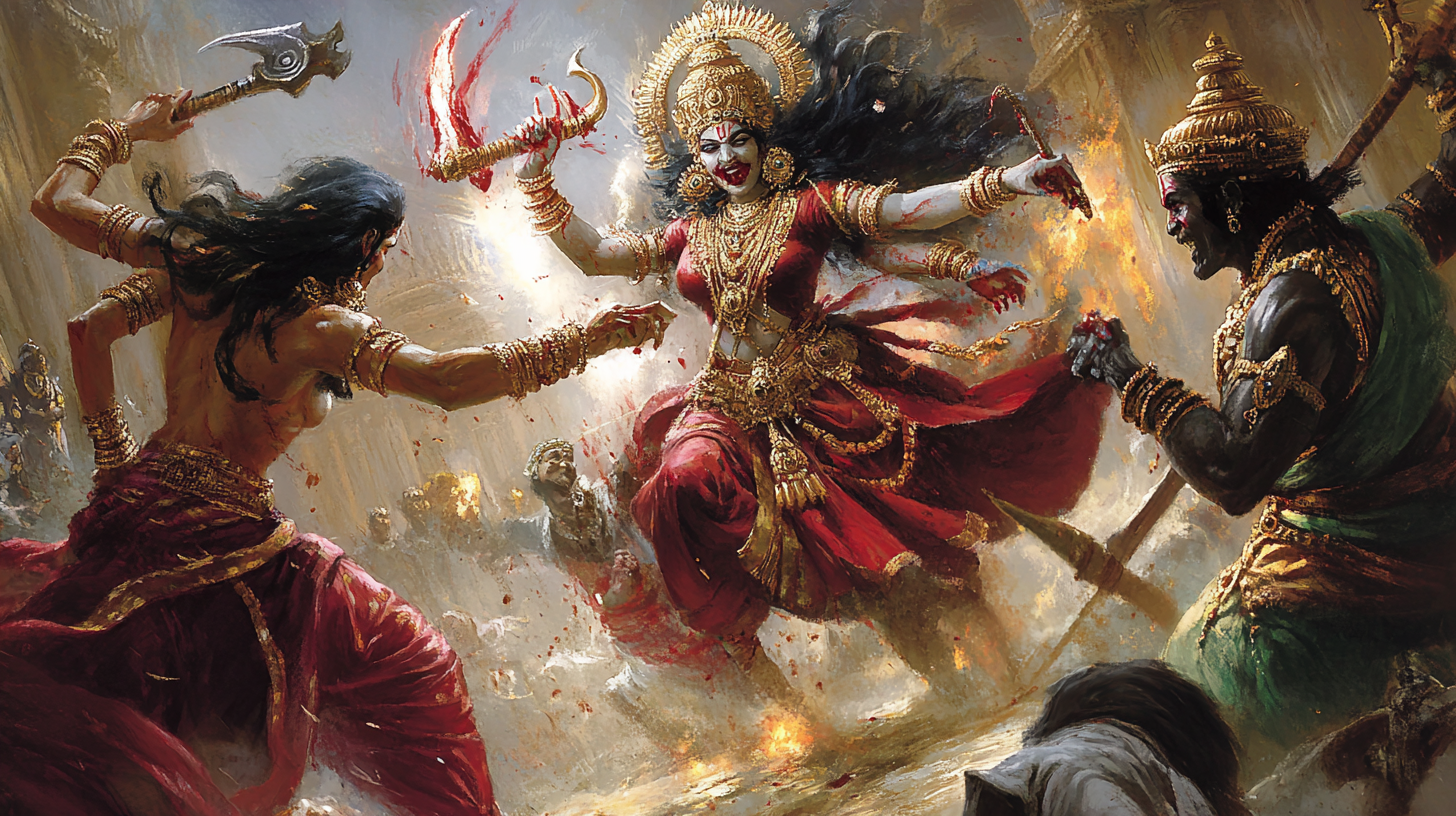
The Destruction of Raktabeej
Among Shumbha’s army was Raktabeej, a demon with a terrifying boon—every time a drop of his blood touched the ground, a new clone of him would rise. As Maa Durga’s weapons struck him, thousands of his replicas emerged, overwhelming the battlefield.
Seeing this, Maa Durga summoned Kali, who spread her giant tongue across the battlefield. As Durga struck Raktabeej down, Kali drank his blood before it could touch the ground, preventing new clones from forming. Raktabeej fell, ending his reign of terror forever.
👉 Want to know more about powerful gods? Read about Shiva’s might: How Powerful is Shiva?
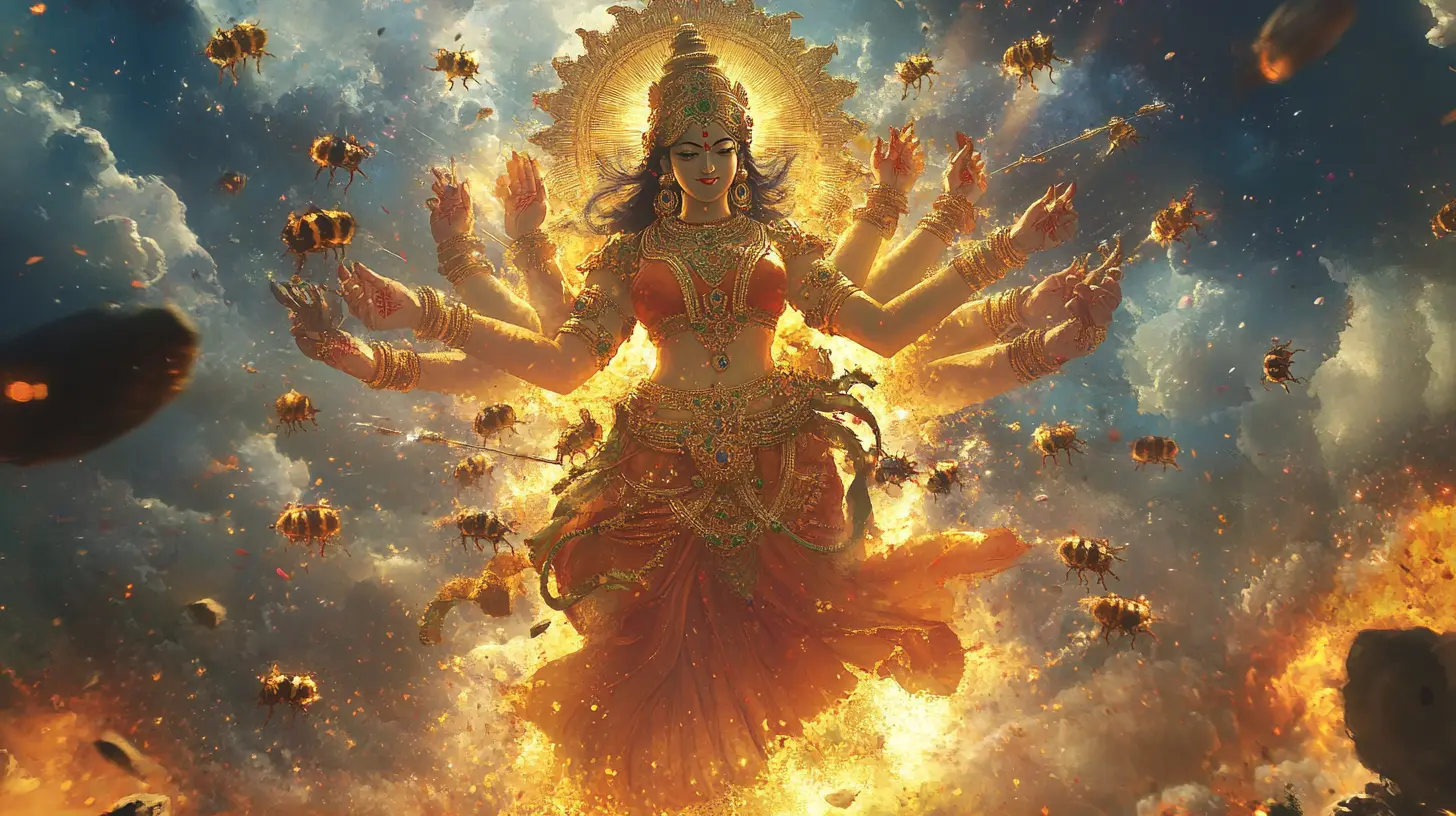
The Battle with Arunasura
Long after Mahishasura’s fall, another demon named Arunasura sought revenge. He performed severe penance and gained a boon that no two- or four-legged creature could kill him. Confident in his invincibility, he began attacking sages and disrupting cosmic balance.
The gods once again prayed to Maa Durga, who appeared as Bhramari Devi, the goddess of bees. In a unique battle, she unleashed a swarm of divine bees, which attacked Arunasura relentlessly. Given that insects did not fall under his boon, he was defenseless, and his tyranny came to an end.
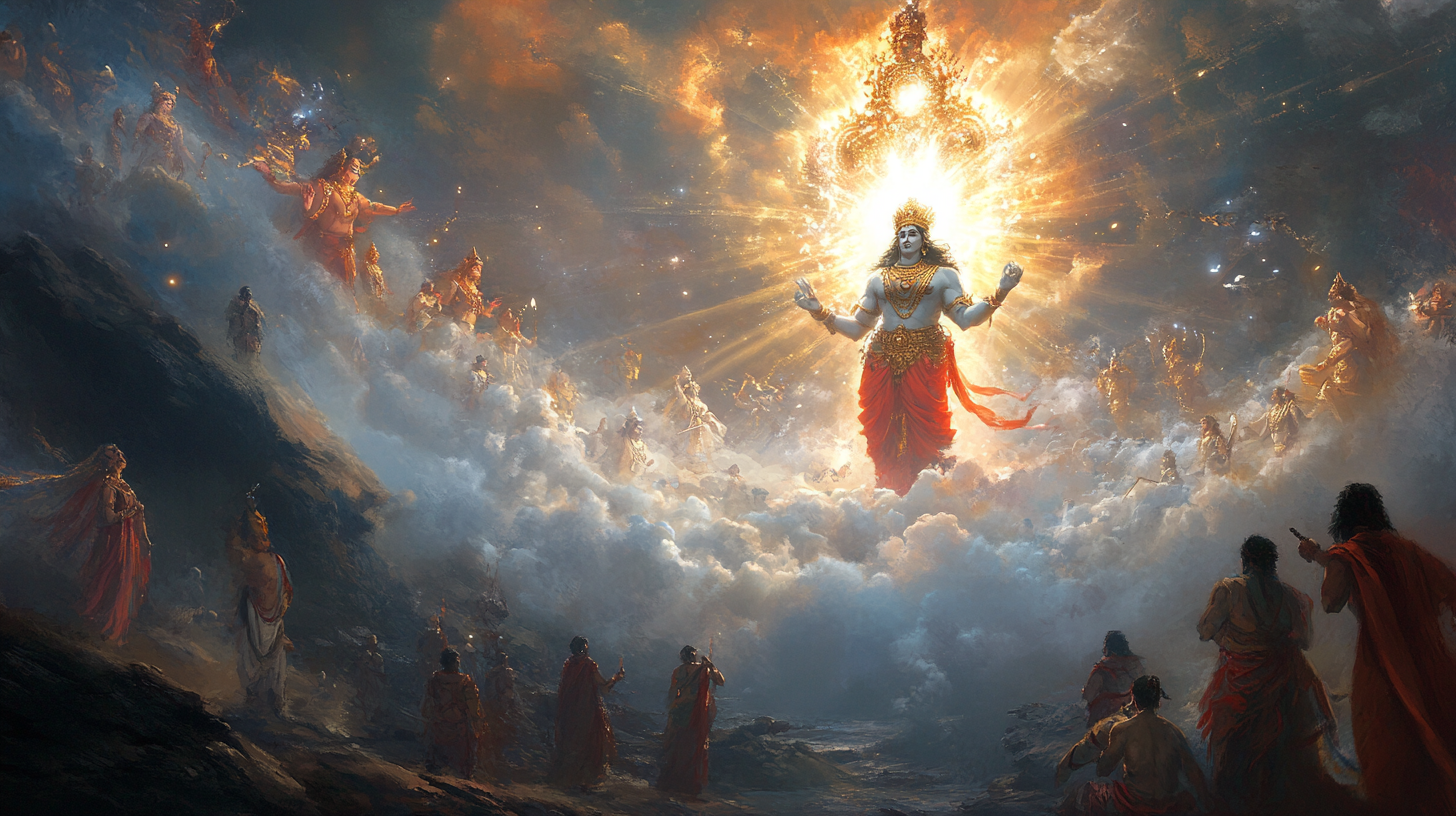
Durga’s War with the Asura-King Durgamasura
In Dvapara Yuga, a powerful asura named Durgamasura gained control over the Vedas through penance. As the wisdom of the universe faded, the gods became powerless, and chaos spread across creation.
Maa Durga, angered by this disruption, descended in her most radiant form, destroying Durgamasura and restoring the lost Vedic knowledge. After this victory, she became known as Durga, the remover of obstacles and ignorance.
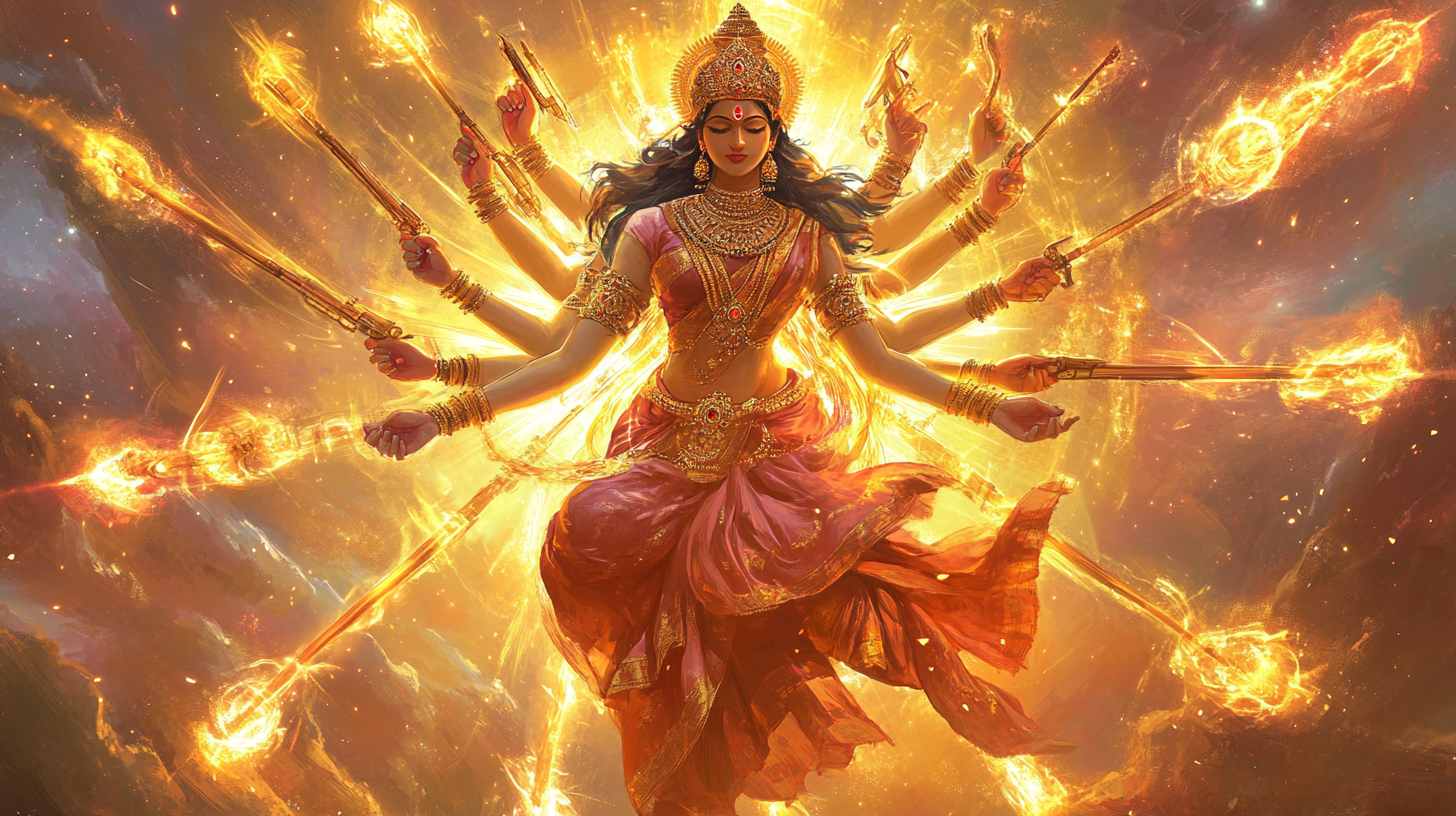
When Maa Durga Tested Lord Indra
There was a time when Indra, the king of gods, grew arrogant after his victories over demons. To teach him humility, Maa Durga appeared in disguise as a divine woman and challenged him to a duel. Despite his celestial weapons, Indra could not defeat her. Realizing her supreme power, he surrendered and bowed before her, acknowledging that all strength comes from her divine energy.
👉 Learn more about divine wisdom and guru devotion: Guru Purnima: Date & Significance
Symbolism and Powers of Durga's Divine Weapons
Once upon a time, when Maa Durga emerged from the combined energies of the gods, they each bestowed upon her divine weapons, empowering her to restore cosmic balance. Each of these weapons carries deep spiritual meaning, reflecting her supreme power over creation, preservation, and destruction.
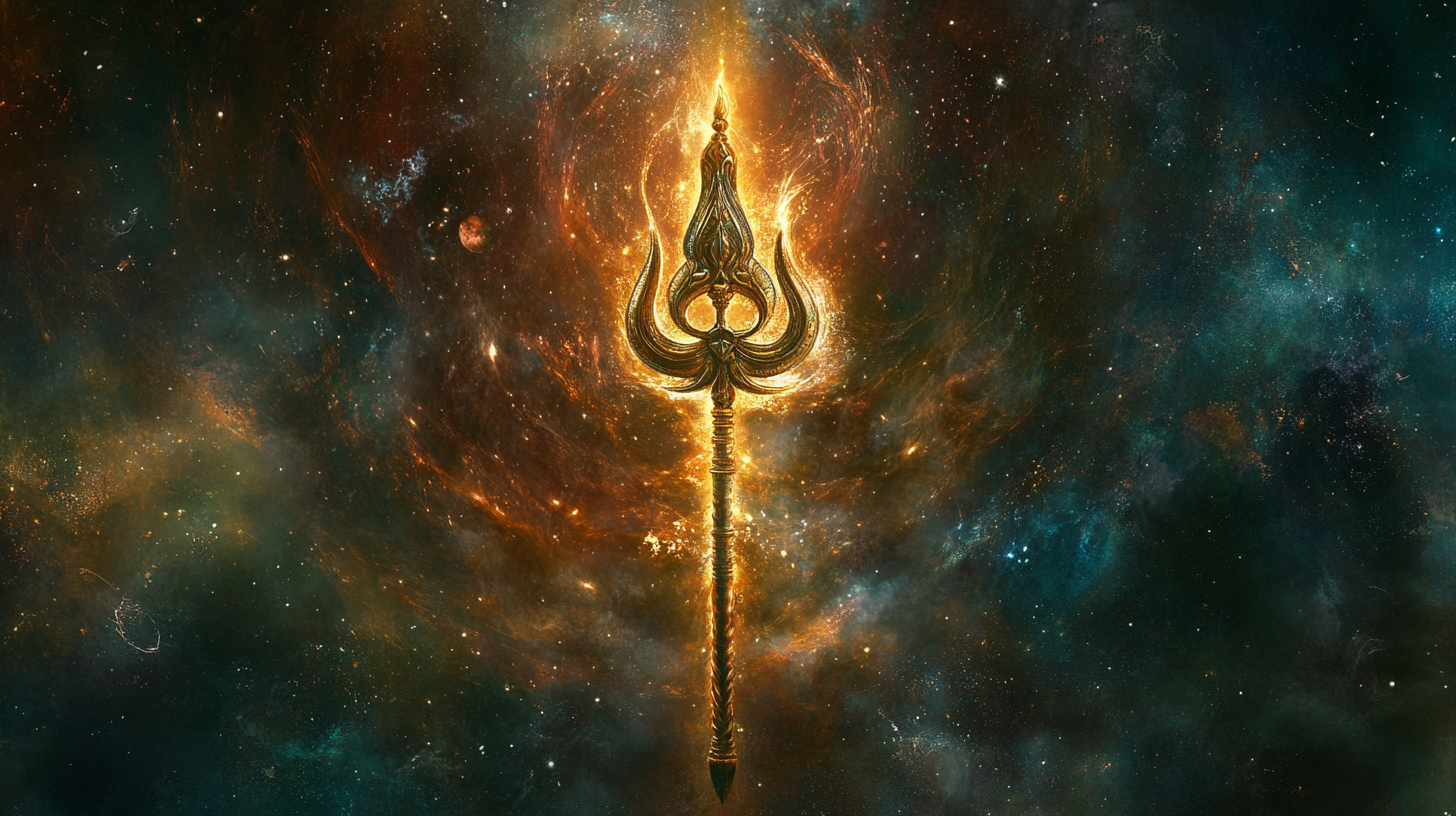
Trishul (Trident): The Balance of the Three Gunas
In the vast expanse of the cosmos, everything operates under the influence of three gunas (qualities)—Sattva (purity), Rajas (passion), and Tamas (ignorance). The Trishul, gifted by Lord Shiva, represents the perfect balance of these forces.
⚡ Power: It signifies that Maa Durga controls the past, present, and future and can annihilate all forms of suffering—physical, mental, and spiritual. With a single thrust of her trident, she destroyed Mahishasura, proving that dharma always prevails.
👉 Read about Shiva’s immense power and his connection to the Trishul: How Powerful is Shiva?
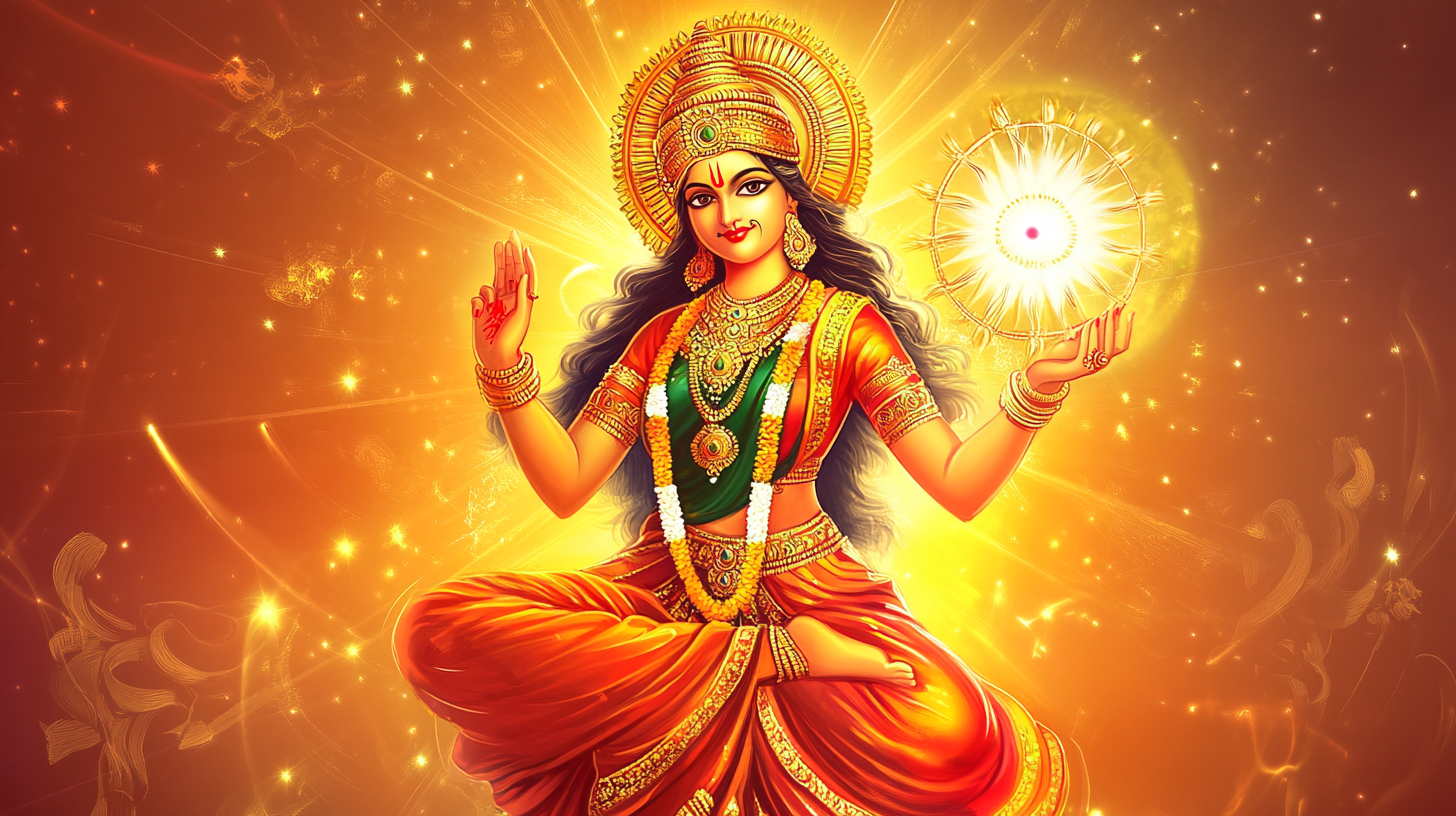
Sudarshan Chakra (Discus): The Cycle of Creation and Destruction
As the battlefield echoed with war cries, Lord Vishnu handed Maa Durga the Sudarshan Chakra, the divine discus that represents the eternal cycle of time—creation, preservation, and destruction. The chakra, spinning at unimaginable speed, is said to cut through all illusions and ego, ensuring divine justice.
⚡ Power: The Sudarshan Chakra is the most lethal celestial weapon. It ensures evil is eradicated at its very root. When Raktabeej’s clones multiplied endlessly, Maa Durga summoned Kali. Kali absorbed his blood before it touched the ground, stopping his rebirth.
👉 Curious about the origins of this celestial weapon? Who Gave Sudarshan Chakra to Krishna?
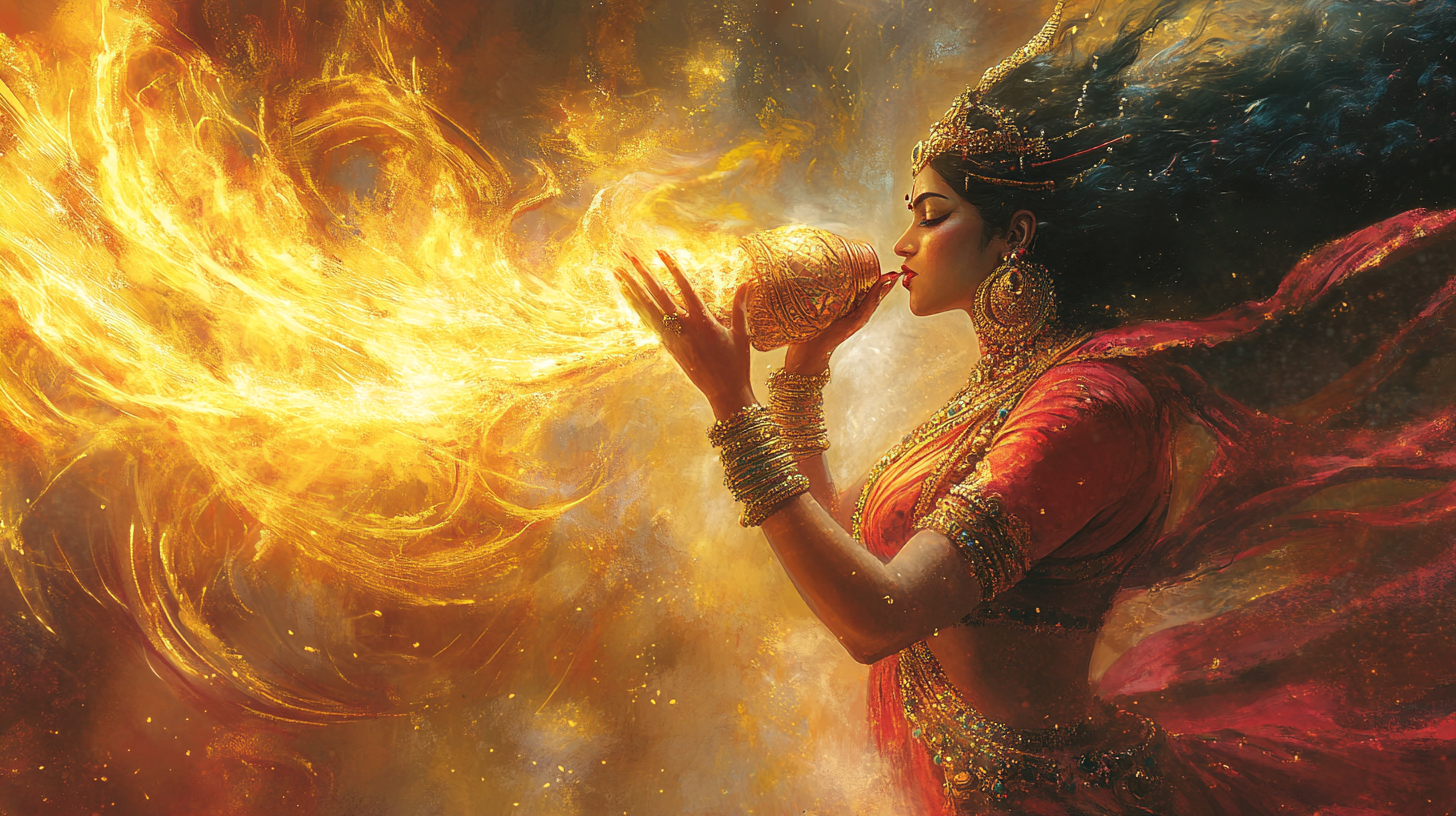
Shankha (Conch Shell): The Primordial Sound of Creation
The Shankha, given by Varuna (God of the Oceans), holds the vibrations of the cosmos. When Maa Durga blows the conch, it resonates with the sound of ‘Om’. This divine frequency marks the beginning of creation and the destruction of ignorance.
⚡ Power: The sound of the conch is said to clear negativity, awaken divine consciousness, and summon celestial forces for battle. Before her war against Shumbha and Nishumbha, Maa Durga’s conch blast sent shockwaves through the heavens. It signaled the impending destruction of evil.
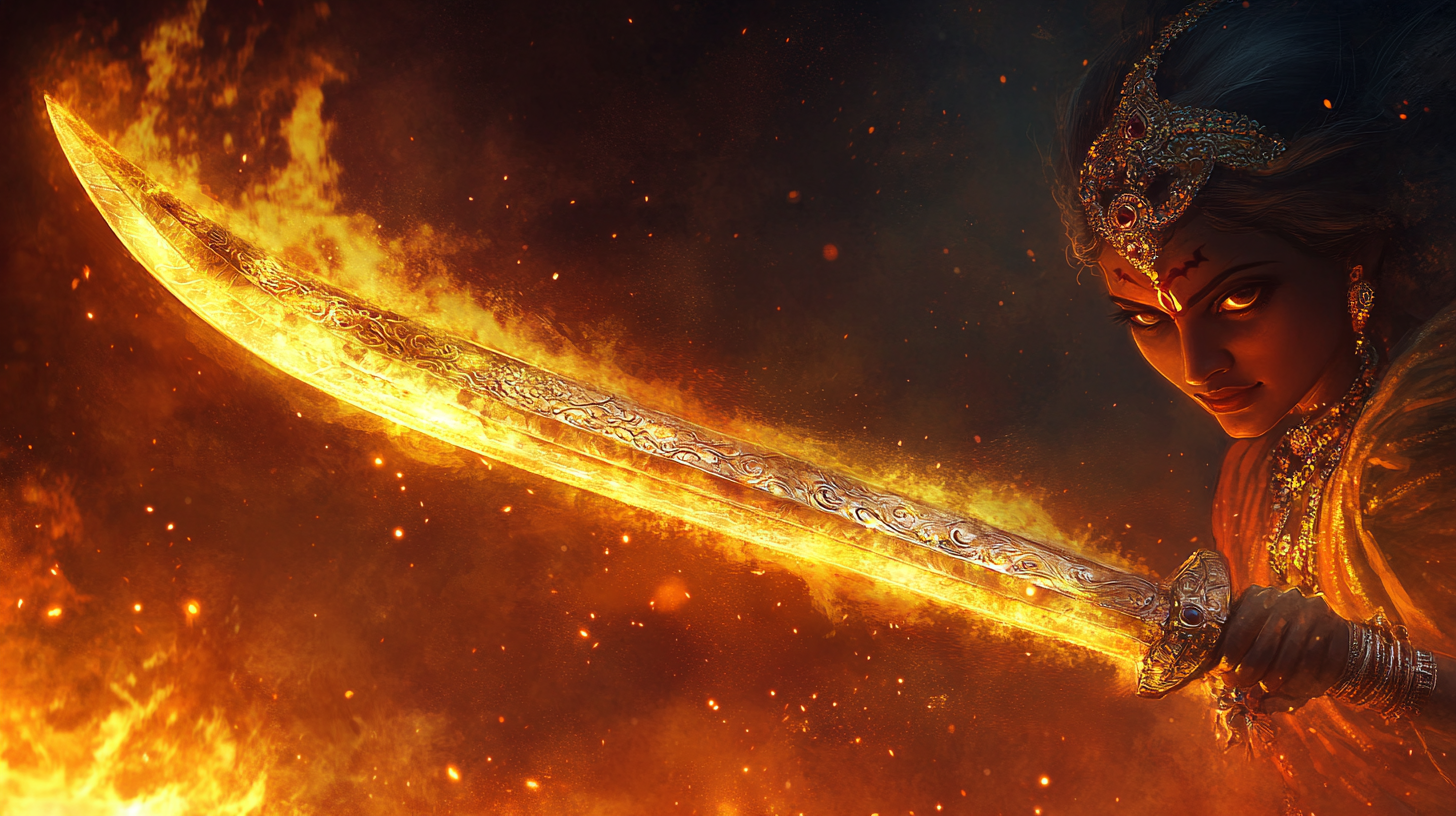
Talwar (Sword): The Sharpness of Intellect
Gifted by Lord Ganesh, the Talwar (sword) represents wisdom, intellect, and the power to cut through deception. No force can stand against a mind sharpened with truth. This sword is a reminder that knowledge is the greatest weapon of all.
⚡ Power: When Indra grew arrogant, Maa Durga tested his strength. Even with all his divine weapons, he failed to defeat her. In that moment, he realized that intellect and wisdom reign supreme over mere physical power.
👉 Explore the wisdom of Lord Ganesha and his divine consorts: Riddhi and Siddhi: The Divine Wives of Lord Ganesha
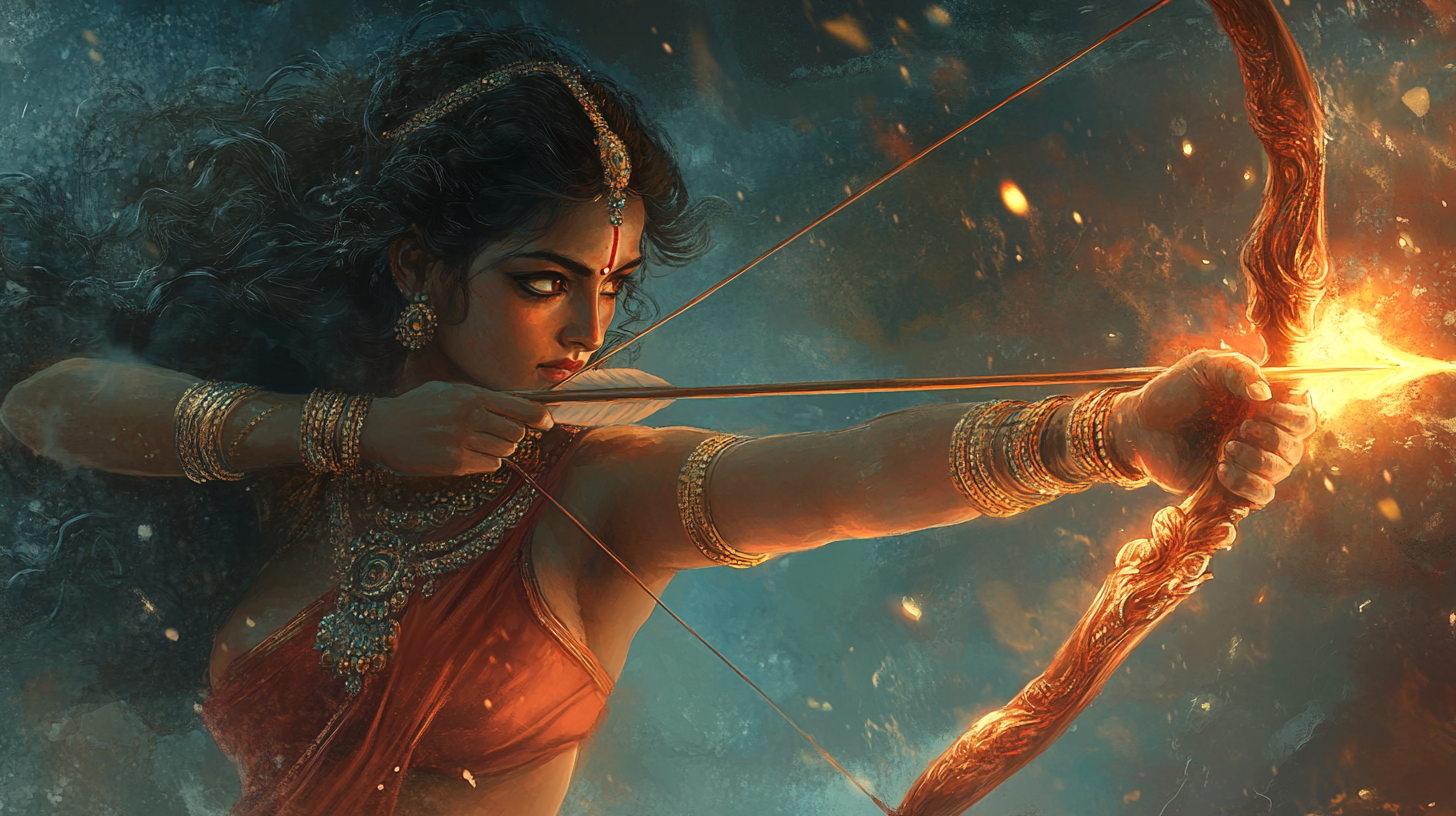
Dhanush and Baan (Bow and Arrow): Energy and Focused Intent
From Surya Deva (the Sun God), Maa Durga received the bow and arrow, symbols of energy, willpower, and unwavering focus. Just as the arrow never turns back once released, her divine energy is unstoppable once set into motion.
⚡ Power: In her battle against Durgamasura, Maa Durga’s arrows rained upon the battlefield. They pierced through illusions and restored the lost Vedas to the world. The bow teaches that true power lies in channeling energy toward a single, righteous purpose.

Gada (Mace): The Power to Crush Evil
The mace (Gada), gifted by Lord Hanuman and Lord Vishnu, is a symbol of immense physical strength and divine authority. It represents unshakable devotion and the power to crush even the most powerful adversaries.
⚡ Power: When Dhumralochan charged at Maa Durga, she didn't need a weapon. A mere roar from her was enough to turn him to ashes. Yet, in other battles, she used the gada to shatter the skulls of demons. This shows that righteousness always prevails.
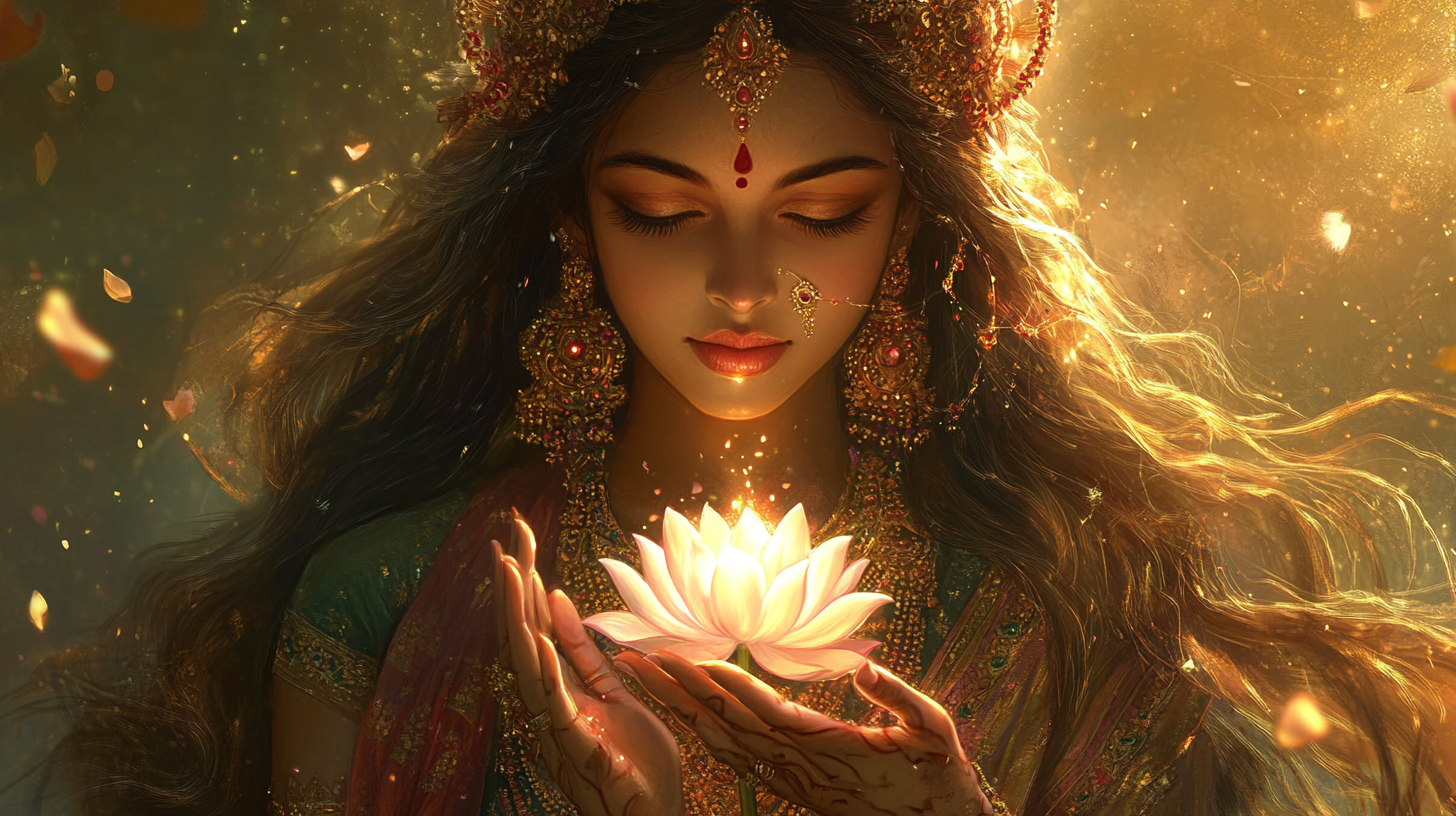
Padma (Lotus): Purity Amidst Chaos
The Padma (lotus), gifted by Brahma, symbolizes spiritual awakening, purity, and resilience. The lotus blooms even in the muddiest waters, mirroring dharma's ability to thrive even in the darkest times.
⚡ Power: Amidst intense wars and destruction, Maa Durga holds the lotus in one hand. This reminds the universe that true power lies in maintaining purity of mind and heart. It signifies that while she destroys evil, she also nurtures creation and wisdom.
👉 Discover more about divine knowledge and Guru devotion: Guru Purnima: Date & Significance
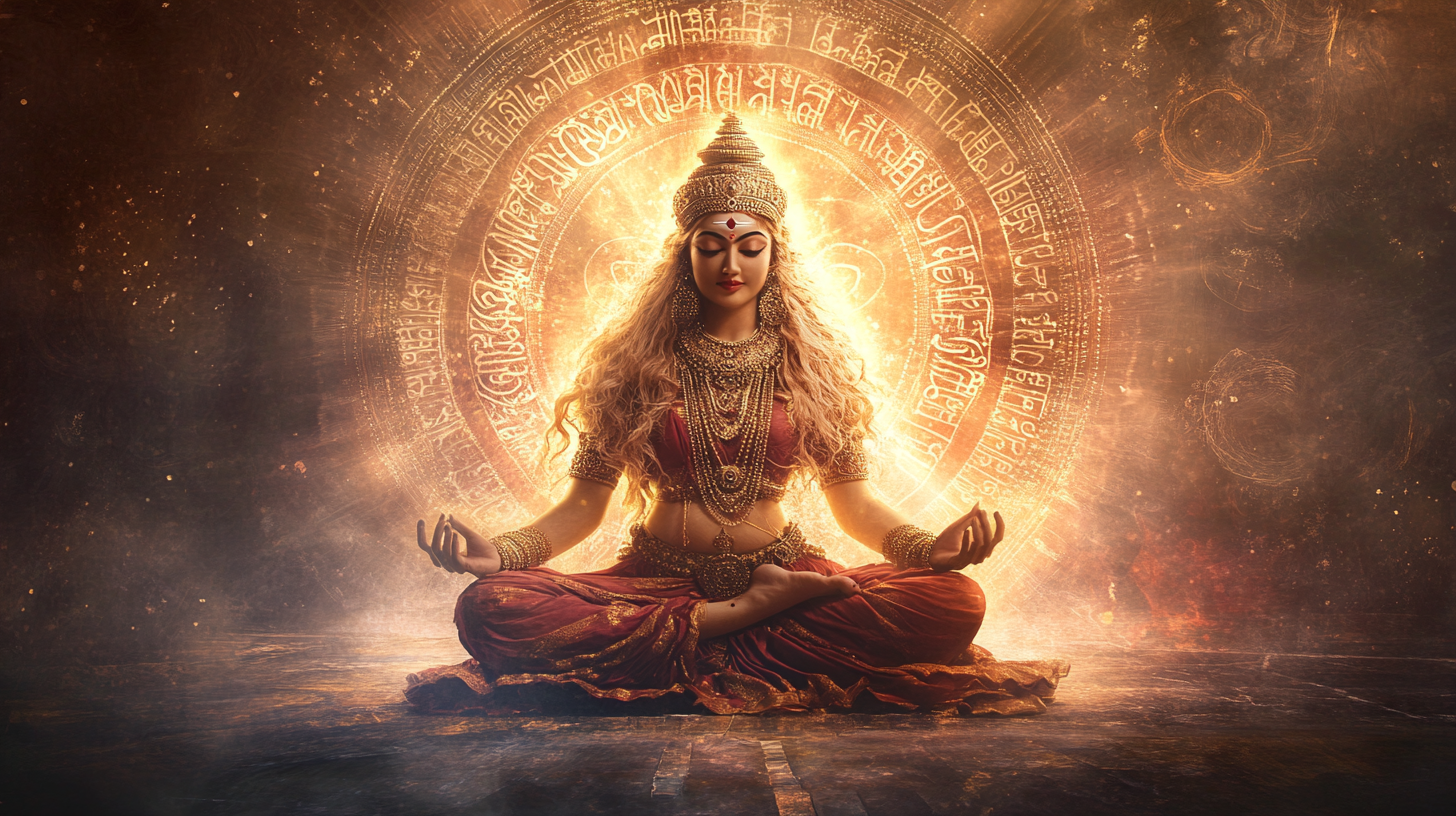
Durga Mantra and Its Meaning
Most Powerful Durga Mantra:
"ॐ ऐं ह्रीं क्लीं चामुण्डायै विच्चे।।"
"Om Aim Hreem Kleem Chamundaye Vichche।।"
Meaning:
"Om" – The universal sound that connects with the divine.
"Aim" – The seed mantra of Saraswati, invoking wisdom and knowledge.
"Hreem" – The mantra of Mahamaya (the Great Illusion), representing purity and strength.
"Kleem" – The mantra of attraction and power, associated with Kali and Durga.
"Chamundaye" – A form of Durga who destroyed the demons Chanda and Munda, representing victory over evil.
"Vichche" – A sound vibration that grants protection and success.
Power of the Mantra:
Removes negativity and obstacles.
Grants strength, courage, and success.
Protects against evil forces and negative energies.
Other Important Durga Mantras and Their Meanings
Durga Gayatri Mantra
"ॐ कात्यायनाय विद्महे कन्याकुमारि धीमहि तन्नो दुर्गि प्रचोदयात्।।"
"Om Katyayanaya Vidmahe Kanyakumari Dhimahi Tanno Durga Prachodayat।।"
✅ Meaning:
Invokes Maa Katyayani, a form of Durga, to bless us with strength, wisdom, and spiritual enlightenment.
Removes obstacles in life, specially for those seeking marriage and happiness.
Mahishasura Mardini Mantra
"ॐ जयन्ती मङ्गला काली भद्रकाली कपालिनी।
दुर्गा शिवा क्षमा धात्री स्वाहा स्वधा नमोऽस्तुते।।"
✅ Meaning:
Salutes Goddess Durga in her powerful forms (Jayanti, Mangala, Kali, Bhadrakali, etc.), seeking her divine protection.
Destroys evil and grants peace, wisdom, and prosperity.
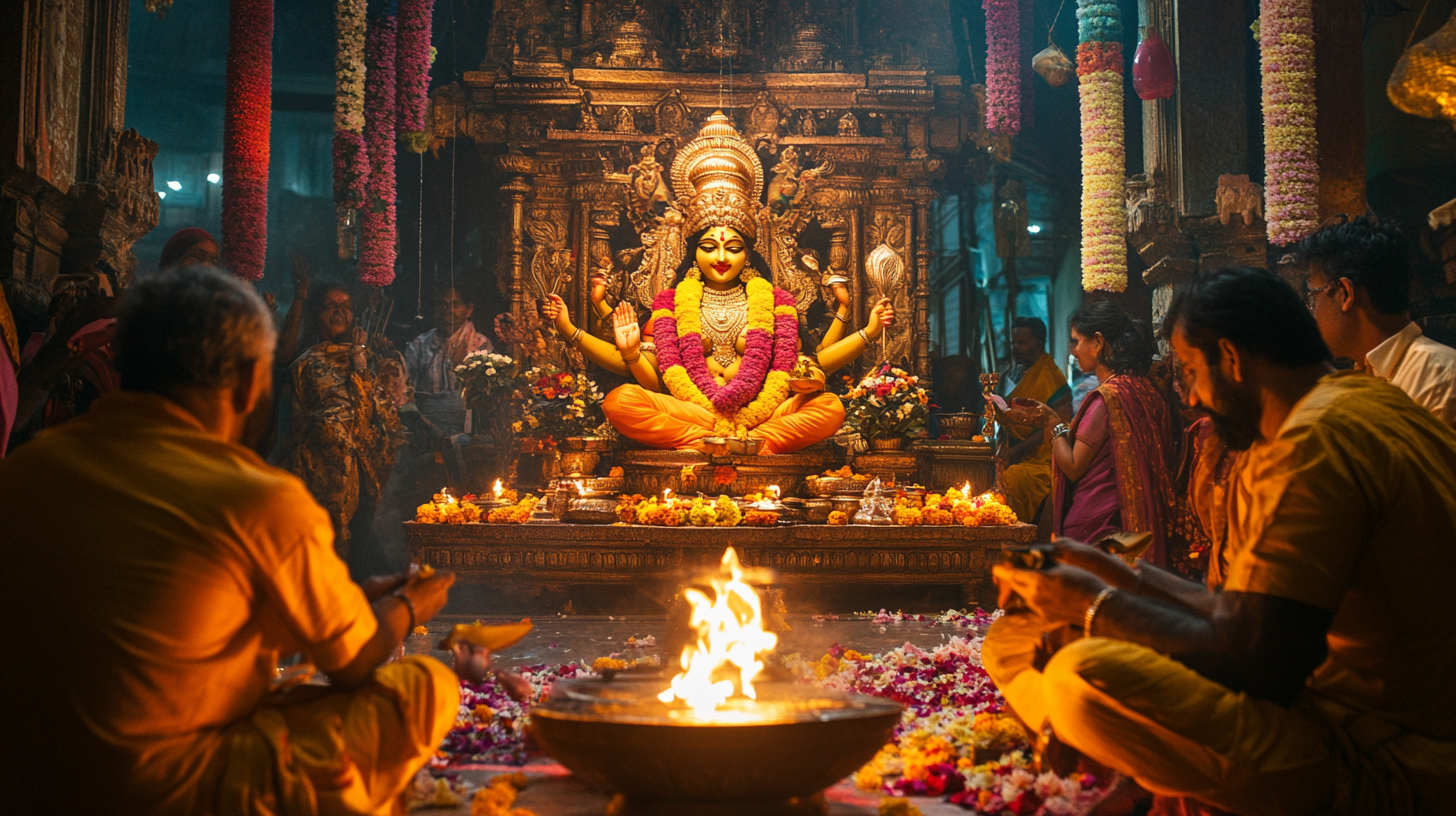
Rituals and Traditions of Durga Puja
Puja Vidhi: Step-by-Step Guide to Performing Durga Puja at Home
Preparation:
Cleanse the Puja Space – Purify the house and puja area with Gangajal (holy water).
Set Up the Altar – Place an idol or image of Maa Durga on a clean, red cloth-covered altar.
Gather Puja Items – Flowers, diya (lamp), incense sticks, kumkum, sindoor, chandan, fruits, sweets, coconut, and kalash.
Puja Rituals:
Ghatasthapana (Kalash Sthapana) – Place a Kalash filled with water and mango leaves as a symbol of divine energy.
Sankalp (Resolution) – Take a vow to complete the puja with devotion.
Invocation of Durga (Avahan) – Light the diya and incense, chant Durga mantras, and meditate on the Goddess.
Offer Flowers (Pushpanjali) – Offer flowers while chanting "Om Dum Durgaye Namah."
Aarti and Bhog Offerings – Sing Durga Aarti and offer sweets, fruits, and coconut.
Prasad Distribution – Distribute blessed food (Prasad) among family and devotees.
🔸 Best Time for Durga Puja: Morning or evening, preferably during Brahma Muhurat (pre-dawn) or Sandhya Kal (evening).
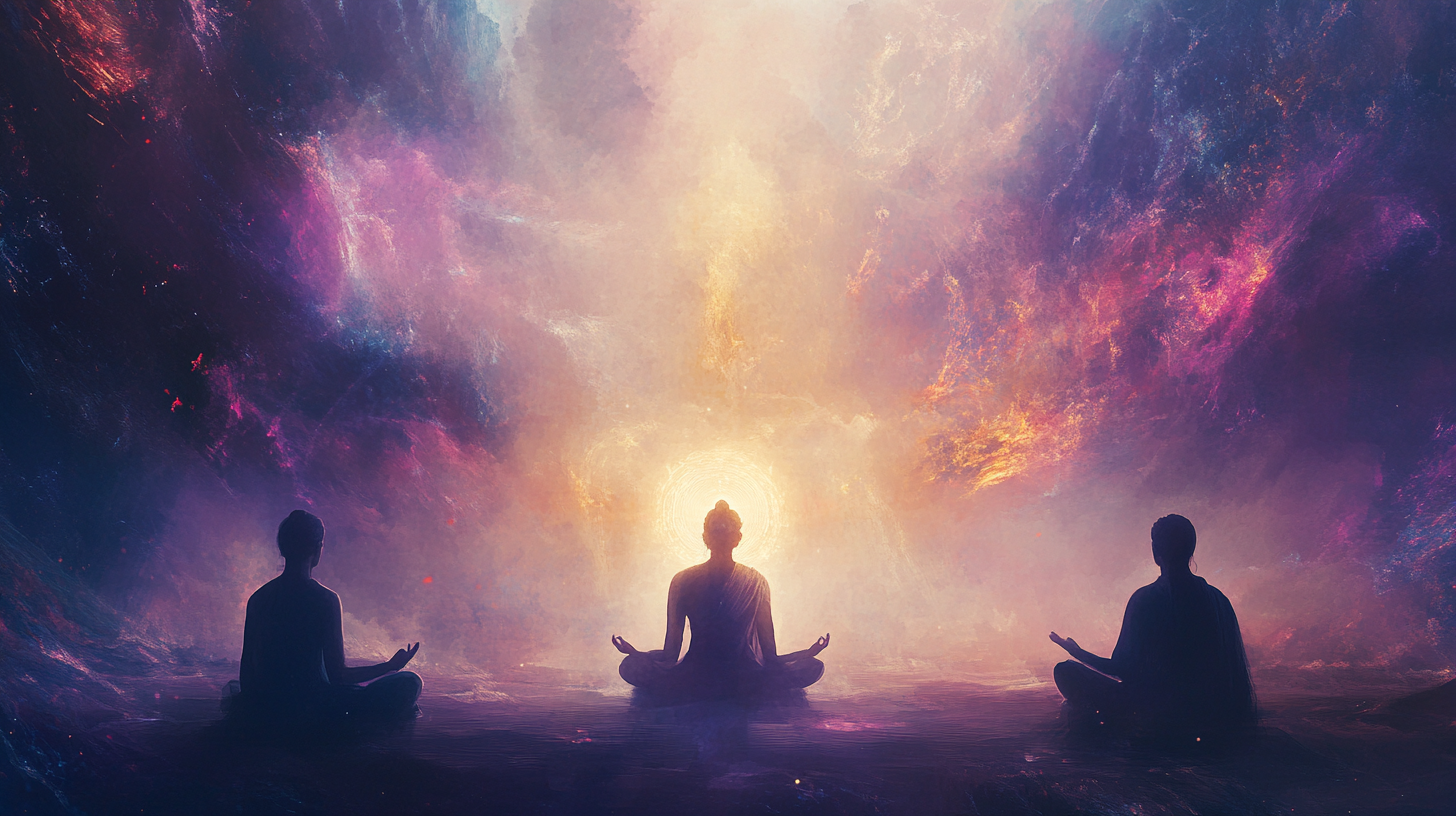
Fasting (Vrat) Guidelines: Types and Significance
Durga fasting (Vrat) is observed to seek Maa Durga’s blessings for prosperity, health, and spiritual growth.
Types of Durga Vrat:
Navratri Vrat (9-Day Fasting):
· Most common fast during Sharad and Chaitra Navratri.
· Devotees observe a full fast (only fruits and milk) or a partial fast (one meal per day).
· Each day is dedicated to one of the Navadurga forms.
Saptami, Ashtami, and Navami Vrat:
· Many devotees fast on the last three days of Navratri.
· Kanya Pujan (worship of young girls as Goddess Durga) is performed on Ashtami or Navami.
Weekly Durga Vrat (Tuesday or Friday Fast):
· Devotees fast on Tuesdays and Fridays to honor Durga and Lakshmi.
· Observers eat only saatvik food (no onion, garlic, or grains) and chant Durga mantras.
Monthly Durga Ashtami Vrat:
· Observed on the eighth day of every lunar month to remove obstacles.
Fasting Guidelines and Benefits:
✅ What to Eat?
· Fruits, milk, dry fruits, coconut water, and juices are allowed.
· Some people eat Sabudana (tapioca), kuttu (buckwheat), singhara (water chestnut flour), and samak rice.
· Rock salt (sendha namak) is used instead of regular salt.
✅ What to Avoid?
· Onion, garlic, non-vegetarian food, alcohol, and grains are prohibited.
✅ Spiritual Benefits of Fasting:
· Cleanses the body and mind.
· Increases devotion, focus, and inner strength.
· Helps in seeking divine protection and prosperity.
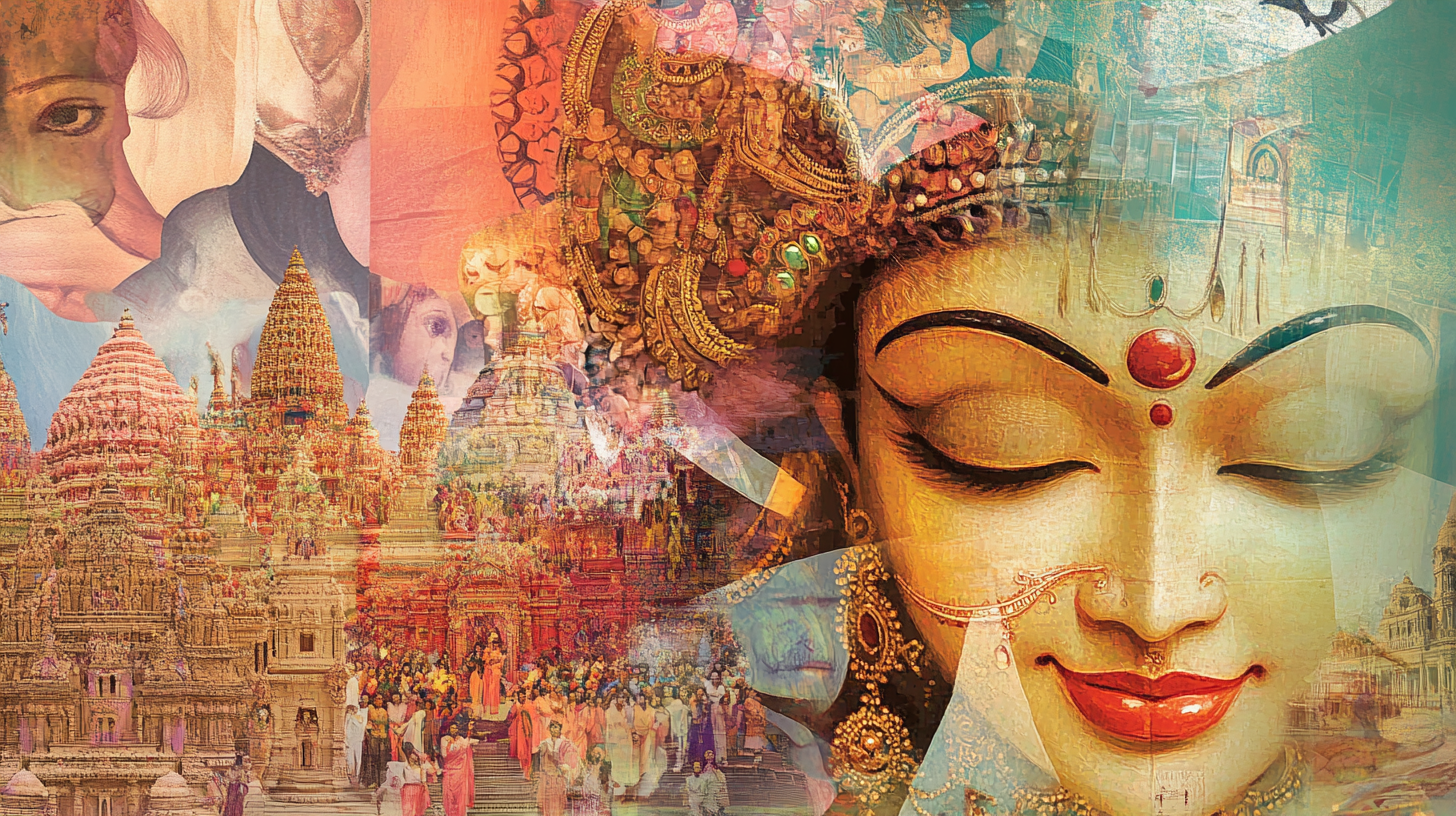
Different Regional Celebrations of Durga Puja in India
Durga Puja is celebrated across India with diverse rituals, traditions, and cultural significance. The essence remains the same—worshipping Maa Durga as the destroyer of evil and protector of the righteous. Yet, each region has its unique customs and celebrations.
1. West Bengal, Assam, and Odisha – Grand Durga Puja
🔸 Main Features:
- The most famous and elaborate Durga Puja celebrations occur in West Bengal, specially in Kolkata.
- Massive pandals (temporary temples) are built, showing artistic themes.
- Kumari Puja (worship of young girls as Goddess Durga) and Sindoor Khela (married women applying sindoor) are key rituals.
- The last day (Vijaya Dashami) involves the immersion (Visarjan) of Durga idols in rivers.
🔸 Specialty:
- Dhunuchi Naach – Devotees perform a traditional dance with smoke-filled earthen pots.
- Bhog Prasad includes khichuri, labra, chutney, and sweets.
- Sandhi Puja marks the transition between Ashtami and Navami with 108 lamps lit in devotion.
2. North India (Uttar Pradesh, Delhi, Punjab, Haryana) – Ramlila & Dussehra
🔸 Main Features:
- In North India, Durga Puja merges with Navratri celebrations, where people fast for nine days and worship different forms of Maa Durga.
- Ramlila performances (theatrical enactments of Ramayana) take place, culminating in Ravana Dahan (burning of Ravana effigies) on Dussehra.
- Huge Durga pandals are set up in cities like Delhi, Lucknow, and Varanasi.
🔸 Specialty:
- Garba and Dandiya Raas in some parts, where people dance in groups with sticks.
- Kanya Puja (worship of nine little girls as forms of Durga) on Ashtami/Navami.
- Ramleela Grounds in Delhi witness massive crowds on Dussehra.
3. Gujarat – Navratri and Garba Nights
🔸 Main Features:
- Gujarat celebrates Durga Puja with Navratri Garba and Dandiya Raas, vibrant folk dances dedicated to Maa Durga.
- People fast during Navratri, eating only satvik food.
- Jagran (all-night bhajans and devotional singing) is common in temples.
🔸 Specialty:
- Falguni Pathak’s Garba events in Ahmedabad and Mumbai are famous.
- Women perform Garba around the Durga idol, wearing traditional chaniya choli.
- Navratri Ghat Sthapana – A sacred pot is kept in homes for worship throughout Navratri.
4. Maharashtra – Navratri & Ghatsthapana
🔸 Main Features:
- Durga Puja in Maharashtra is linked with Navratri fasting, devotional singing (bhajans), and Ghatsthapana (Kalash Sthapana).
- Families set up Golu dolls (tiered display of idols).
- Dussehra is marked by exchange of Apta leaves (considered gold) as blessings.
🔸 Specialty:
- Warkari community performs Kirtans in temples.
- Apta tree leaves (symbolizing gold) are exchanged among family and friends.
- Celebrations in Mumbai include huge Durga pandals, with Bollywood celebrities attending.
5. Tamil Nadu – Golu Dolls and Ayudha Puja
🔸 Main Features:
- Durga Puja in Tamil Nadu is celebrated through Bommai Golu – a traditional arrangement of dolls on stepped platforms in homes.
- Ayudha Puja is a major ritual where people worship their tools, books, and vehicles as a tribute to Goddess Durga and Saraswati.
- Saraswati Puja is performed on the last three days of Navratri.
🔸 Specialty:
- Young girls perform Kolattam (stick dance) in temples.
- People place musical instruments and books before the deity.
- Vehicles are decorated and worshipped on Ayudha Puja.
6. Karnataka – Mysore Dasara (Royal Celebrations)
🔸 Main Features:
- Mysore Dasara is one of the grandest celebrations in Karnataka, where the royal family leads the worship of Chamundeshwari (Durga’s form).
- The Mysore Palace is illuminated with thousands of lights.
- Procession of elephants carrying the idol of Goddess Chamundeshwari.
🔸 Specialty:
- Mysore’s famous Jumbo Savari (elephant procession).
- The Wadiyar royal family performs traditional rituals.
- Ayudha Puja is observed, similar to Tamil Nadu.
7. Kerala – Saraswati Puja and Vijaya Dashami
🔸 Main Features:
- Kerala celebrates Durga Puja as Saraswati Puja, focusing on education and wisdom.
- Children perform "Vidyarambham" (initiation into learning) on Vijaya Dashami.
- Devotees visit temples to offer prayers to Goddess Saraswati, Durga, and Lakshmi.
🔸 Specialty:
- Books are placed before the Goddess and not touched for two days.
- Children write their first letters in rice grains.
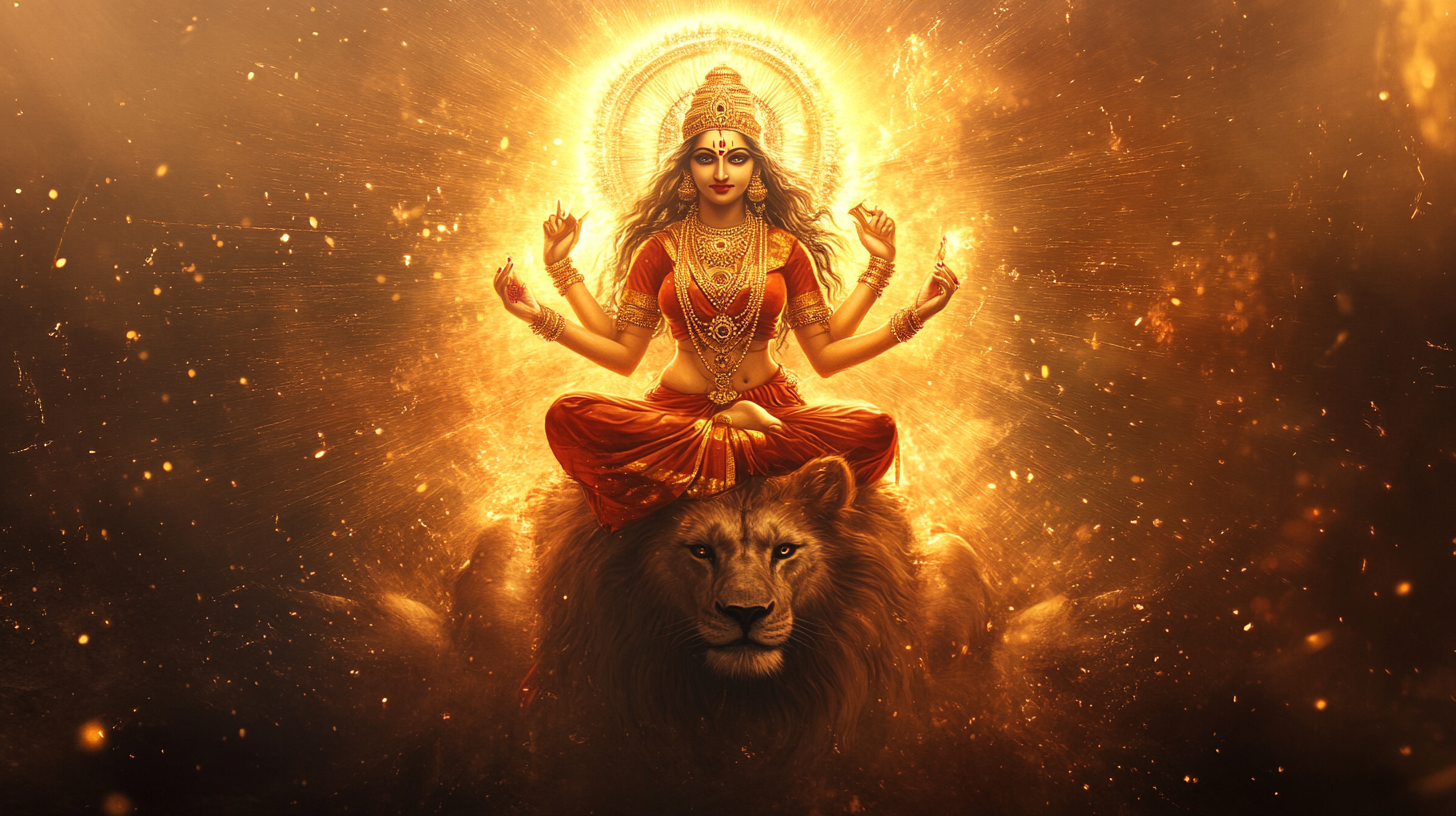
Conclusion
Goddess Durga, the embodiment of divine strength and compassion, continues to inspire millions with her tales of valor and grace. Her presence unites devotees across regions, reminding us of the eternal battle between good and evil. Worshiping Maa Durga not only brings blessings but also instills courage, wisdom, and devotion in our hearts.
If you're seeking a divine connection and wish to keep the blessings of the Goddess close, explore our beautifully crafted God Idols under the brand 'Dev Tattva'. Whether for your car dashboard, temple, home, or office, our idols are designed to radiate spiritual energy and positivity wherever they are placed.
🌟 Bring home divine blessings today! Visit our collection here: Dev Tattva Idols 🙏✨
Our latest content
Check out what's new in our company !
Goddess Durga: Origins, Pooja, Symbolism, and the Nine Divine Forms